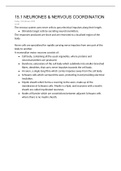15.1 NEURONES & NERVOUS COORDINATION
Friday, 25 February 2022
16:08
The nervous system uses nerve cells to pass electrical impulses along their length.
● Stimulate target cells by secreting neurotransmitters.
The responses produced are short and are restricted to a localised region of the
body.
Nerve cells are specialised for rapidly carrying nerve impulses from one part of the
body to another.
A mammalian motor neurone consists of:
● Cell body, containing all the usual organelles, where proteins and
neurotransmitters are produced.
● Dendrons, extensions of the cell body which subdivide into smaller branched
fibres, dendrites, that carry nerve impulses towards the cell body.
● An axon, a single long fibre which carries impulses away from the cell body.
● Schwann cells which surround the axon, protecting it and providing electrical
insulation.
● Myelin sheath which forms a covering to the axon, made up of the
membranes of Schwann cells. Myelin is a lipid, and neurones with a myelin
sheath are called myelinated neurones.
● Nodes of Ranvier which are constrictions between adjacent Schwann cells
where there is no myelin sheath.
,15.2 THE NERVE IMPULSE
Friday, 25 February 2022
17:26
A nerve impulse is a wave of electrical activity which travels along the axon
membrane.
● Temporary reversal of potential difference across the axon membrane
between resting and action potential.
The movement of ions, Na+ and K+, across the axon membrane is regulated and
controlled by:
● Phospholipid bilayer prevents ions diffusing across membrane.
● Channel proteins have ion channels which can be opened or closed so ions can
move through by facilitated diffusion at certain times. Some channels remain
permanently open.
● Some carrier proteins actively transport K+ ions into and Na+ ions out of the
axon. The Na-K pump.
In the neurones resting state, there are more positively charged ions on the outside
of the axon compared to the inside.
● Inside is negatively charged in comparison to outside.
This is the resting potential and the membrane is said to be polarised as there is a
potential difference across it.
The establishment of this potential difference is due to:
● Na+ ions actively transported out of axon by Na-K pump.
● K+ ions actively transported into axon by Na-K pump.
● 3 Na+ ions move out of the axon for every 2 K+ ions which move in.
● Outward movement of Na+ is therefore greater than the inward movement of
K+, so more Na+ in tissue fluid surrounding axon than in cytoplasm and more
K+ in cytoplasm than tissue fluid.
● An electrochemical gradient is established.
● Na+ ions diffuse back into axon and K+ diffuse out of the axon.
● Most K+ protein channels are open but most Na+ channels are closed, so not
many Na+ diffuse back into axon as membrane is more permeable for K⁺.
● This makes outside more positively charged than inside.
When a stimulus of sufficient size is detected by a receptor, its energy causes a
temporary reversal of the charges either side of the axon membrane, a rapid change
in potential difference.
This is an action potential and the axon membrane is said to be depolarised.
, ● The negative charge of -65mV inside membrane becomes positive 40mV.
The depolarisation occurs due to protein channels changing shape to open or close,
depending on the voltage across the membrane.
● Voltage-gated channels.
An action potential occurs as:
● At resting potential, some K+ voltage-gated channels are open but all Na+
voltage-gated channels are closed. At resting potential, Na+ are outside axon
and K+ are inside.
● The energy of the stimulus causes some Na+ voltage-gated channels to open,
allowing Na+ ions to diffuse into the axon down the electrochemical gradient.
● As the Na+ are positive, they trigger a reversal in the potential difference
across the membrane.
● As the Na+ ions diffuse into axon, depolarisation causes more Na+ channels
open, causing a grater influx of Na+ ions. The membrane becomes
depolarised.
● Once the action potential of around 40mV is established, the Na+ voltage-
gated channels close and the K+ channels open.
● As some K+ channels now open, electrical gradient is now reversed, allowing
more K+ channels to open, therefore more K+ diffuses out of the axon,
starting repolarisation of the axon.
● There is an overshoot of diffusion of K+ out of the axon as the K+ channels
close slowly, so inside of axon becomes more negative than usual, and so the
membrane is hyperpolarised as the potential difference is more negative than
the resting potential.
● Na-K pump pumps Na+ out and K+ into axon, resulting in the membrane
returning back to its resting potential and is repolarised, until exited by
another stimulus.




